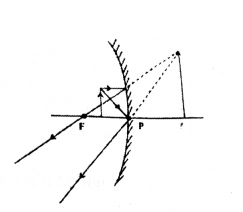AP 10th Class Physics 9th Lesson Light Reflection and Refraction Important Questions
Class 10 Physical Science Chapter 9 Important Questions - 1 Mark
Question 1.
What is light?
Answer:
Light is a form of energy. It brings the sensation of sight. It is a form of electromagnetic radiation. It also provides us means of communication (fibre-optics).
Question 2.
Write any one observation from every day life. Which show us that light travels in a straight line.
Answer:
A small source of light casts a sharp shadow of an opaque object tells us that light travels in a straight line.
Question 3.
What is a ray ?
Answer:
Ray is a line defining the path of light.
Question 4.
What is beam?
Answer:
A bundle of rays originating from the same source of light in a particular difection is called beam of light.
Question 5.
Explain why a ray of light passing through the centre of curvature of a concave mirror, gets reflected along the same path.
Answer:
The ray passing through the centre of curvature incident to the mirror along its normal, so, ∠i = ∠r = 0. Therefore, the ray retraces its path.
Question 6.
Is light a ray or a wave ?
Answer:
It is considered in both the forms.
Question 7.
What are the characters associated with light as a wave ?
Answer:
Frequency and wavelength.
Question 8.
What is spherical mirror ?
Answer:
A reflecting surface which is of the form of a sphere (hollow) in which inner or outer surface is reflecting.
Question 9.
What is the relation connecting focal length and radius of a spherical mirror ?
Answer:
f = R2.
Question 10.
Can any spherical surface act as a reflector ?
Answer:
Yes, polished surface can be better reflectors.
Question 11.
For what position of object, a concave mirror forms a real image equal to size of object ?
Answer:
When object is placed at the centre of curvature (c) same size real image is formed by concave mirror.
Question 12.
A concave mirror forms a sharp image of a distant tree. What name is given to the distance between the concave mirror and screen on which sharp image is formed ?
Answer:
Focal length.
Question 13.
In what condition, the image formed by a concave mirror is virtual ?
Answer:
When the object is placed between the focus and the pole of a concave mirror, a virtual image is obtained.
Question 14.
Specified the size of image formed by a concave mirror when m > 1.
Answer:
The image is enlarged.
Question 15.
Name the mirror that can be used to check theft in shops.
Answer:
Convex mirror.
Question 16.
What is the position of the object placed on the side of reflecting surface of a concave mirror of focal length 15 cm if the image is formed at the distance of 30 cm from the mirror ?
Answer:
30 cm
Question 17.
Which mirror, concave or convex always converges the light rays.
Answer:
Concave mirror.
Question 18.
For what position of the object does a concave mirror forms a real image which is highly enlarged ?
Answer:
At F.
Question 19.
When object is placed at centre of curvature of concave mirror, where is the image formed ?
Answer:
At C.
Question 20.
Size of the image formed on a concave mirror is highly diminished, state the position of object and image.
Answer:
Position of object: at infinity.
Position of image : at the focus F.
Question 21.
Find the value Of angle of emergence when an incident ray makes an angle of 40° with a normal; to air glass interface of the rectangular glass slab.
Answer:
40°, as angle of emergence = angle of incidence.
Question 22.
How is the refractive index of the medium related to the speed of light through it ?
Answer:
Refractive index of a medium = Speed of light in vacuum Speed of light in medium
Question 23.
The speed of light in a transparent medium is 0.6 times that of its speed in vacuum. What is the refractive index of the medium ?
Answer:
Since n = cv, we get
n = c0.6c = 10.6 = 1.66
Question 24.
Define the term reflection.
Answer:
The bouncing back of light when it strikes a smooth or polished surface is called reflection of light.
Question 25.
What type of image is formed by a plane mirror ?
Answer:
The image formed by a plane mirror is unmagnified, virtual and erect and has right - left reversal.
Question 26.
Can a plane mirror be called a spherical mirror ?
Answer:
Yes, of infinite focal length.
Question 27.
What is the radius of curvature of a plane mirror ?
Answer:
The radius of curvature of plane mirror is infinity.
Question 28.
How many images are formed by two parallel mirrors ?
Answer:
Infinite images.
Question 29.
A ray of light is incident on the plane mirror normally. What are the angle of incidence and the angle of reflection ?
Answer:
i = 0, r = 0.
Question 30.
What is focal length of a plane mirror ?
Answer:
Infinity.
Question 31.
If the radius of curvature of concave mirror is 36 cm, what is its focal length ?
Answer:
The focal length is half the radius of curvature i.e., 18 cm.
Question 32.
What type of mirror is used to obtain a real image ?
Answer:
A concave mirror.
Question 33.
The image formed by a concave mirror is real and of the same size, where is the object placed.
Answer:
It is placed at the centre of curvature.
Question 34.
A ray is incident along ACB on a spherical mirror where C is the centre of curvature. In which direction will be ray be reflected ?
Answer:
The ray will retrace its path along BCA.
Question 35.
If you want to see an enlarged image Of your face, which type of mirror will you use? where will you place your face ?
Answer:
A concave mirror The face should be placed between the pole and the focus of the mirror.
Question 36.
For what position of the object does a concave mirror, from a real diminished image of an object ?
Answer:
The object should be beyond the centre of curvature.
Question 37.
Which mirror has a large field of view ?
Answer:
A convex mirror.
Question 38.
Which mirror is used by dentists ?
Answer:
A concave mirror.
Question 39.
Explain why do drivers prefer to use a convex mirror or a back view mirror in automobiles ?
Answer:
It produces an erect and a diminished image.
Question 40.
What does positive magnification mean ?
Answer:
It means that the size of the image is more than that of the object.
Question 41.
What does negative magnification mean ?
Answer:
It means that the size of the image is less than that of the object.
Question 42.
Give the relationship of magnification with focal length of a spherical mirror.
Answer:
m = f?vf = ff-u
Question 43.
The magnification of a mirror is +1. What does it mean ?
Answer:
It means that the size of the image is equal to the size of the object.
Question 44.
Write the relationship of object distance (u), image distance (v) and focal length (f).
Answer:
1u+1v=1f.
Question 45.
What are the urlits of refractive index ?
Answer:
It does not have any units.
Question 46.
What is the effect on the wavelength of light when it travels from rarer to denser medium ?
Answer:
The wavelength of light decreases when it travels from a rarer to a denser medium.
Question 47.
What is a lens ?
Answer:
A lens is an optical system with two refracting surfaces.
Question 48.
The image formed by a lens is always erect and diminished. What is the nature of the lens ?
Answer:
It is a concave lens.
Question 49.
For what position of the object does a convex lens from an erect and virtual image?
Answer:
When the object lies between the optical centre and the focus of the lens.
Question 50.
What are the units of power of a lehs ?
Answer:
Dioptre.
Question 51.
From which point of a lens are all the distance measured.
Answer:
All the distances are measured from the optical centre of the lens.
Question 52.
What is the power of plane glass sheet ?
Answer:
Its power is zero.
Question 53.
A thin lens has a focal length of - 12 cm. Is it a convex lens or cancave leijs ?
Answer:
It is concave lens.
Question 54.
What is the expression for magnification of a lens ?
Answer:
It is given by m = ?vu.
Question 55.
An incident ray falls normally on a glass slab, what is the angle of refraction ?
Answer:
Zero.
Question 56.
What does Figure represent in the document ?
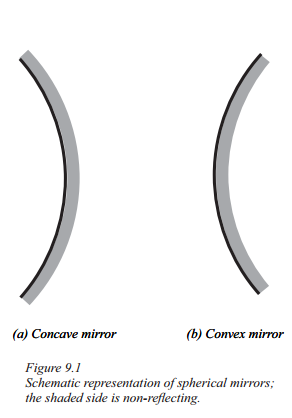
Answer:
Figure represents a schematic representation of spherical mirrors, with the shaded side indicating the non-reflecting side.
Question 57.
The radius of curvature of a converging mirror is 30 cm. At what distance from the mirror should an object be placed so as to obtain a virtual image ?
Answer:
Between 0 cm and 15 cm
Question 58.
The refractive index of medium A is 1.5 and that of medium B is 1.33. If the spe,ed of light in air is 3 x 10s m/s, what is the speed of light in medium A and B respectively?
Answer:
2 × 108 m/s and 2.25 × 108 m/s
Question 59.
A student very cautiously traces the path of a ray through a glass slab for different values of the angle of incidence (∠i). He then measures the corresponding value of the angle of refraction (∠r) and the angle of emergence (∠e) for every value of the angle of incidence. On analyzing these measurements of angles, what would be his conclusion ?
Answer:
∠i = ∠e > ∠r
Question 60.
The following diagram shows the use of an optical device to perform an experiment of light. As per the arrangement shown, what is likely to be the optical device ?
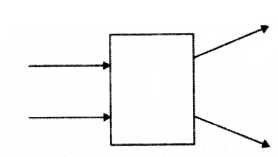
Answer:
The optical device is a concave lens.
Question 61.
If a lens converge the sun rays at a point 20 cm, away from its optical centre, then what is the power of this lens ?
Answer:
The power of the lens is + 5D.
Question 62.
A student was asked his teacher to find the image distance for various object distance in case of a given convex lens. He performed the experiment with all precautions and noted down his observations in the following table.
| S.No. |
Object distance (cms) |
Image distance (cms) |
| 1 |
60 |
15 |
| 2 |
48 |
16 |
| 3 |
36 |
21 |
| 4 |
24 |
24 |
| 5 |
18 |
36 |
| 6 |
16 |
48 |
After checking the observation table the teacher pointed out that there is a mistake in recording the image distance in one of.the observations. Find the serial number of the observation having faulty image distance.
Answer:
The serial number ‘3’ having faulty image distance.
Question 63.
Out of the five incident rays shown in the figure find the three rays that are obeying the laws of refraction and may be used for locating the position of image formed by a convex lens:
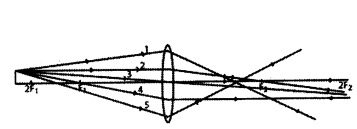
Answer:
2, 3 and 4 rays are obeying the laws of refraction.
Question 64.
Study the diagram given below and identify the type of the lens XX’ and the position of the point
on the principal axis OO’ where the image of the object AB appears to be formed?
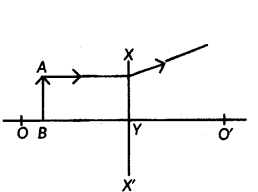
Answer:
Type of the lens is Concave. The image of the object AB appears to be formed between O and Y.
Question 65.
Assertion (A) : A concave lens of very short focal length causes higher divergence than one with tiger focal length.
Reason (R) : The power of a lens is directly or tiportional to Its focal length
A) Both Assertion (A) and Reason (R) are true and Reason (R) is the correct explanation of the Assertion (A).
B) Both Assertion (A) and Reason (R) are true, but Reason (R) is not the correct expla
nation of the Assertion (A).
C) Assertion (A) is true, but Reason (R) is false
D) Assertion (Â) Is false, but Reason (R) is true.
Answer:
C) Assertion (A) is true, but Reason (R) Is false
Question 66.
Rays from Sun converge at a point 15 cm in front of a conncave mirror. Where should an object be placed so that size of its image is equal to the size of the object?
Answer:
30 cm in front of the mirror.
Question 67.
Consider these indices of refraction: glass: 1.52; air: 1.0003; water: 1.333. Based on the refractive indices of three materials, arrange the speed of light through them in decreasing order.
Answer:
The speed of light in air > the speed of light in water > the speed of light in glass.
Question 68.
If the real image of a candle flame formed by a lens is three times the size of the flame and the distance between lens and image is 80 cm, at what distance should the candle be placed from the lens ?
Answer:
The candle be placed from the lens at - 80/3 cm.
Question 69.
The refractive index of glass is 1.50. What is the meaning of this statement ?
Answer:
When we say that refractive index of glass is 1.5 we mean that speed of light in galss
? = cn=3×1081.5ms-1 = 2 x 108 ms-1

Question 70.
Consider the following diagram in which M is a mirror and P is an object and Q is its magnified image formed by the mirror.
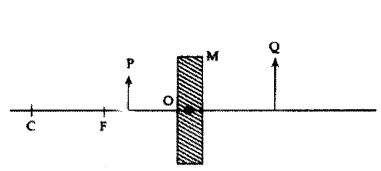
State the type of the mirror M and one characteristic property of the image Q.
Answer:
Concave mirror. Image Q is a virtual image.
Question 71.
What is the nature (convergent/divergent) of the combination of a convex lens of power + 4D and a concave lens of power -2D?
Answer:
The combination of a convex lens with power + 4D and a concave lens with power - 2D is convergent, with a power of + 2D.
Pcombined = P1 + P = + 4D + (- 2D) = + 2 D.
The combination of lenses behaves like a convex lens because the power of the combination is positive.
Light Reflection and Refraction Class 10 Important Questions - 2 Marks
Question 1.
Re-draw the diagram given below and show the direction of the light ray after reflection from the mirror.
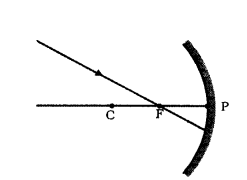
Answer:
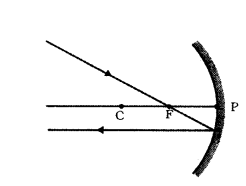
Question 2.
Name the type of mirror used in the following and reason for using it
a) Solar furnace
b) Rear veiw mirror in a vehicle.
Answer:
a) Concave mirror as it reflects light towards a single focal point.
b) Convex mirror as it always produces virtual, erect and diminished image.
Question 3.
Name the type of spherical mirror which
a) has positive focal length
b) always forms a virtual image
Answer:
a) Convex mirror
b) Convex mirror
Question 4.
Write two different uses of concave mirror.
Answer:
a) In solar furnace.
b) In shaving mirror.
Question 5.
What is the magnification of the images formed by plane mirror and why ?
Answer:
The magnification of the images formed by plane mirrors is 1, as the size of the image is equal to the size of object.
Question 6.
When light undergoes refraction at the surface of two media, what happens to the speed of light ?
Answer:
When light enters obliquely from a rarer medium into a denser medium, the speed of light decreases. Also, when light gets into the rarer medium from the denser medium, the speed of light increases.
Question 7.
Can obsolute refractive index of any material be less than one ?
Answer:
No, the velocity of light in the medium is always less than the velocity of light in vaccum.
Question 8.
The following table gives the values of refractive indices of a few media.
| S. No. |
; Medium |
Refractive index |
| i. |
Water |
1.33 |
| 2. |
Crown glass |
1.52 |
| 3. |
Rock salt |
1.54 |
| 4. |
Ruby |
1.71 |
| 5. |
Diamond |
2.42 |
Use this table to give an example of a medium pair so that light speeds up when it goes from one of these media to another.
Answer:
When a ray of light passes from an optically denser (higher refractive index) to a rarer medium (lower refractive index), its speed increases.
For example, crown glass to water.
Question 9.
What happens to a ray of light when it travels from one medium to another having equal refractive index ?
Answer:
The light ray will continue to travel in the same path as there will be no refraction when both the medium having equal refractive index.
Question 10.
Redraw the given diagram and show the path of the refracted ray.
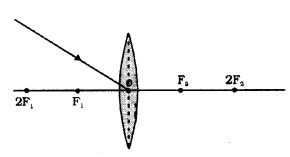
Answer:
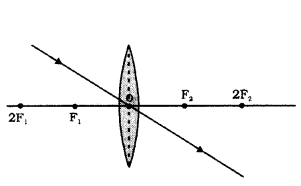
Question 11.
Redraw the diagram given below and show the direction of the light ray after refraction from the lens.
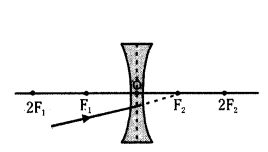
Answer:
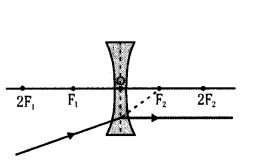
Question 12.
A ray of light is refracted as per the following diagram which media A or B is optically denser than other ?
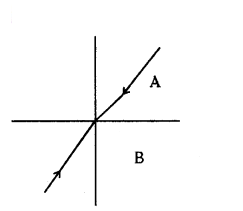
Answer:
The given figure shows that the ray of light bends towards the normal after refraction, when it enters from medium. A to medium B and ∠i > ∠r, This indicates that medium B is optically denser than A.
Question 13.
A convex lens of focal length 25 cm and a concave lens of focal length 10 cm are placed in close contact with each other. Calculate the lens power of this combination.
Answer:
Given, f = 25 cm (convex), f = - 10 (concave)
Power of combination = P = P1 + P2 = 10025 + 100?10 = 4 - 10 = - 6D
Question 14.
Write down four important characteristics of image formed by a plane mirror.
Answer:
- unmagnified
- virtual
- Erect and
- Right- left reversal
Question 15.
What are the advantages and disadvantages of using a convex mirror for seeing traffic at the rear ?
Answer:
Advantage : It gives a wide view of the traffic behind.
Disadvantage : It does not show the correct distance of the vehicle at the rear.
Question 16.
State the snell’s law of refraction.
Answer:
It states "The ratio of the sine of the angle of incidence to the sine of angle of refraction is a constant for a given pair of media".
Question 17.
What is meant by a lateral shift ?
Answer:
When a ray of light emerges out of a glass slab it is parallel to the incident ray but is displaced laterally relative to the incident ray. This shift of the emergent ray is called lateral shift.
Question 18.
What is the velocity of light in a glass slab of refractive index 1.5 ?
Answer:
The velocity of light in the glass slab is given by v = cu=3×1081.5 = 2 × 108 ms-1
Question 19.
How does a glass slab affect the appearance of a straight line drawn beneath it ?
Answer:
- The part of the line under the glass slab appears to be bent at the edges when the slab is inclined to the line.
- When the slab is placed normal to the line, the part of the line beneath the slab appears to be raised.
Question 20.
What are the two positions of the object considered for studying the image formed by a convex mirror ?
Answer:
The two positions of the object considered are :
a) When the object is at infinity
b) When the object is at a finite distance from the mirror.
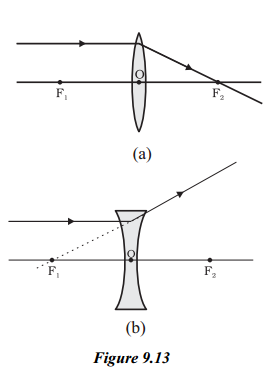
Question 21.
How is the surface of a shining spoon related to a curved mirror ?
Answer:
- The surface of a shining spoon can be considered as a curved mirror.
- The reflecting surface of a spoon curved inwards can be approximated to a concave mirror.
- The reflecting surface of a spoon bulged outwards can be approximated to a convex mirror.
Question 22.
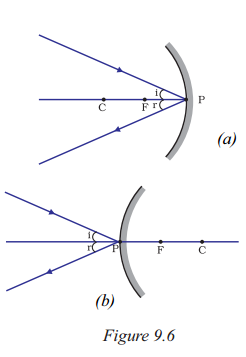
i. What does Figure illustrate ?
Answer:
Figure illustrates the ray diagrams for the image formation by a concave mirror (a) and convex mirror (b).
ii. What can be done with the ray diagrams shown in Figure ?
Answer:
The incident and reflected rays follow the laws of reflection at the point of incidence, making equal angles with principal axis.
Question 23.
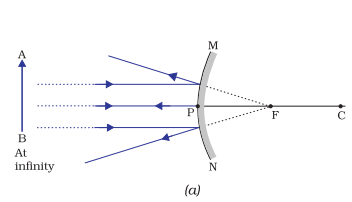
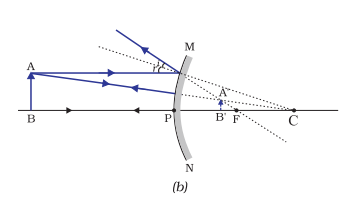
i. What does Figure illustrate?
Answer:
Figure illustrates the ray diagrams for the formation of an image by a convex mirror.
ii. What positions of the object are considered In the ray diagrams?
Answer:
The ray diagrams consider two positions of the object, when the object is at infinity and when the object is at a finite distance from the mirror.
Question 24.
A ray of light is Incident on a convex mirror as shown. Redraw the diagram and complete the path of this ray after reflection from the mirror. Mark angle of incidence and angle of reflection on it.
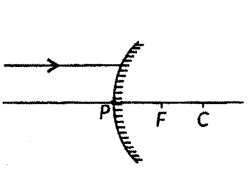
Answer:
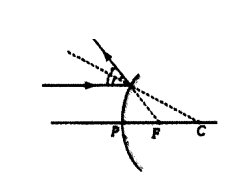
Question 25.
List two properties of the images formed by convex mirrors. Draw ray diagram in support of your answer.
Answer:
Convex mirrors always form diminished, virtual and erect images.
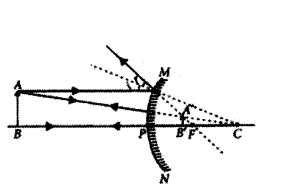
Question 26.
The linear magnification produced by a spherical mirror is + 3. Analyse this value and state the i) type of mirror and (ii) position of the object with respect to the pole of the mirror. Draw a ray diagram to show the formation of image in this case.
Answer:
Positive value of the magnification indicates that image is virtual and erect,
i) Since the image is magnified, the mirror is concave.
ii) The object is between pole and focus of the mirror as shown
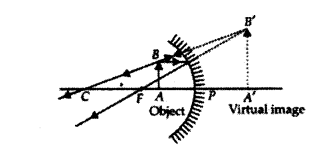
i) Since the image is magnified, the mirror is concave.
Question 27.
The image formed by a concave mirror is observed to be virtual, erect and larger than the object. Where should the position of the object be relative to the mirror? Draw ray diagram to justify your answer.
Answer:
The position of the object should be between P and F
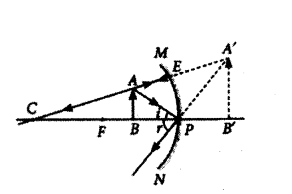
Question 28.
The linear magnification produced by a spherical mirror is + 1/3. Analysing this value state the (i) type of mirror and (ii) position of the object with respect to the pole of the mirror. Draw any diagram to justify your answer.
Answer:
i) Convex mirror
ii) Between infinity and the pole of the mirror.
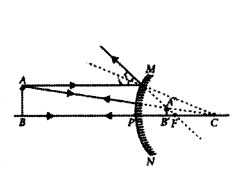
Question 29.
The linear magnification produced by a spherical mirror is - 1. Analysing this value state the (i) type of mirror and (ii) position of the object with respect to the pole of the
i) Concave mirror because the image is real, inverted.
ii) Object is placed at C.
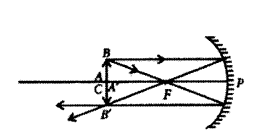
Question 30.
The linear magnification produced by a spherical mirror is - 1/5. Analysing this value state the (i) type of spherical mirror and (ii) the position of the object with respect to the pole of the mirror. Draw ray diagram to justify your answer.
Answer:
i) Concave mirror
ii) Object is placed beyond C.
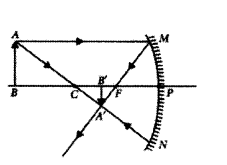
Question 31.
Draw a ray diagram to show the path of the reflected ray corresponding to an incident ray which is directed towards the principal focus of a convex mirror. Mark on it the angle of incidence and the angle of reflection.
Answer:
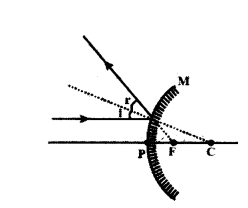
Here i = angle of incidence ; r = angle of reflection
Question 32.
The refractive indices of three media are given below :
| Medium |
Refractive Index |
| A |
1.6 |
| B |
1.8 |
| C |
1.5 |
A ray of light is travelling from A to B and another ray is travelling from B ot C.
a) In which of the two cases the refracted ray bends towards the normal ?
b) In which case does the speed of light increase in the second medium ?
Give reasons for your answer.
Answer:
a) When light travels from an optically rarer medium to an optically denser medium it t moves towards the normal. Since nB > nA hence the light ray will bend towards the normal on passing from medium A to B.
b) The speed of the light will increase when the light travels from B to C, Since nC < nB and V = cn, the speed of light ray will increase in the second medium.
Question 33.
The absolute refractive index of Ruby is 1.7. Find the speed of light in Ruby. The speed of light in vacuum is 3 × 108 m/s.
Answer:
Given, Refractive index of ruby, μ = 1.7
Speed of light in vacuum, c = 3 × 108 m/s ; Refractive index, μ = cv
Here, v = speed of light in ruby ∴ v = cμ = 3×1081.7 = 1.76 × 108 m/s.
Question 34.
A student focuses the image of a well illuminated distant object on a screen using a convex lens. After that he gradually moves the object towards the lens and each time focuses its image on the screen by adjusting the lens.
i) In which direction-towards the screen or away from the screen, does he move the lens ?
ii) What happens to the size of the image-does it decrease or increase ?
iii) What happens to the image on the screen when he moves the object very close to the lens ?
Answer:
i) As the object is moved towards the lens, the image distance increases. Thus, the student moves the lens away from the screen to focus the image.
ii) The size of the image increases when the object is moved towards the lens.
iii) When the object is moved very close to the lens, no image is formed on the screen. A virtual image is formed behind the object on the same side of the screen.
Question 35.
Where should an object be placed in front of a concave mirror of focal length 20 cm so as to obtain a two times magnified virtual image of the object ?
Answer:
Given f = - 20 cm .
m = + 2 because the image is vitural and erect.
?vu = 2v = - 2u
1f=1u+1v ⇒ 1?20=1u?12u ⇒ 1?20=12u ⇒ 2u = -20 ⇒ u = -10 cm.
Question 36.
Study the ray diagram given below and answer the questions that follow :
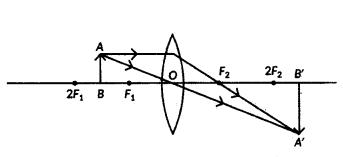
a) Is the type of lens used converging or diverging?
b) List three characteristics of the image formed.
c) In which position of the object will the magnification be - 1 ?
Answer:
a) Convex lens
b) Real, inverted, enlarged
c) When object is at 2F.
Question 37.
Find the power of a convex lens which forms a real, and inverted image of magnification - 1 of an object placed at a distance of 20 cm from its optical centre.
Answer:
m = -1 ; u = -20 cm ; v = ? ; f = ?
m = vu ⇒ v = +20 cm
thus object is at 2F i.e., 2f = 20 cm ’
∴ f = 10 cm = 0.1 m ⇒ P = 1f = 10.1 = +10D
Question 38.
A concave mirror produces three times magnified image on a screen. If the objects placed 20 cm in front of the mirror, how far is the screen from the object ?
Answer:
Given : Magnification, m = -3 ; Object distance, u = -20 cm
Magnification, m = ?vu or -3 = ?v?20 or v = -60 cm
The screen is placed in front of the mirror at a distance of 60 cm from the pole.
Thus, the screen is placed 40 cm (= 60 cm - 20 cm) away from the object.
Question 39.
Calculate the focal length of a lens of power - 25 D.
Answer:
- The formula to calculate the focal length (f) of a lens of power (P) is f = .
- So, the focal length of a lens of power - 2.5 D can be calculated as :
f = 1(?2.5D) = -0.4 m or - 40 cm (negative sign indicates that the lens is a concave lens)
- Therefore, the focal length of the lens is - 40 cm.
Important Questions on Light Reflection and Refraction Class 10 - 4 Marks
Question 1.
Write differences between real and virtual images.
Answer:
| Real image |
Virtual image |
| 1) Here the rays actually meet at the image point. |
1) Here the rays appear to diverge from the image point. |
| 2) It can be taken on a screen. |
2) It cannot be taken on a screen. |
| 3) It is always inverted. |
3) It is always erect. |
Question 2.
What is an optical medium ? How can we classify different media on the basis of their behaviour towards light ?
Answer:
Optical medium: A substance through which light can pass is called an optical medium. On the basis of their behaviour towards light, different media can be classified into three categories.
- Transparent substances : A substance through which light can easily pass and objects can be seen clearly is called transparent substance. For example air, water, glass etc.
- Opaque substances : A substance which does not allow light to pass through it is called an opaque substance. For example wood, metal, stone etc.
- Translucent substances : A substance through which light passes only partially and objects are not clearly seen is called a translucent substance. For example, wax paper, frosted glass, clouds, etc.
Question 3.
List four properties of the image formed by a concave mirror, when object is placed between focus and pole of the mirror.
Answer:
i) Behind the mirror
ii) Enlarged, i.e. magnified,
iii) Virtual
iv) Erect
Question 4.
List your specific characteristics of the images of the object formed by convex mirrors.
Answer:
Properties of image formed by a convex mirror.
a) It always formed behind the mirror, between the pole and its focus.
b) The image is always virtual and erect.
c) The size of image is always smallar than the object.
d) Magnification is always positive.
Question 5.
With the help of a ray diagram, state and explain the laws reflection of light at a plane mirror, Mark the angles of incidence and reflection clearly on the diagram.
Answer:
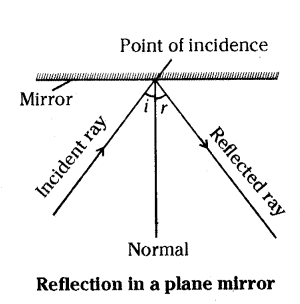
As shown in figure. When a ray of light is incident on a mirror, it gets reflected in accordance with the following laws of reflection.
First law : The angle of incidence (i) is equal to the angle of reflection (r)
∠i = ∠x
Second law : The incident ray, the reflected ray and the normal at the point of incidence all lie in the same plane.
Question 6.
A person is running towards a plane mirror with a speed of 5 m/s. With what speed does his image in the plane mirror appear to him to be moving towards him ?
Answer:
When a person moves towards a mirror, his virtual image also moves towards the mirror by equal distance.
∴ Relative speed of man and his image = 2 × Speed of man towards the mirror
= 2 × 5 = 10 m/s.
Question 7.
Write differences between concave and convex mirrors.
Answer:
| Concave mirror |
Convex mirror |
| 1) It converges a parallel beam of light. |
1) It diverges a parallel beam of light. |
| 2) Image may be real or virtual. |
2) Image is virtual. ’ |
| 3) | m | ≥ 1 or | m | < 1 |
3) | m | < 1. |
Question 8.
Compare any two similarities and one dissimilarity between image formed by a plane mirror and convex mirror in tabular form.
Answer:
| Plane mirror |
Convex mirror |
Similarities
1) It forms erect image. |
1) It forms erect image. |
| 2) Image is virtual. |
2) Image is virtual. |
Dissimilarities
1) Image is of same size of the object. |
1) Image is smaller than the object. |
| 2) Image is at same distance form the mirror as the object is in front of it. |
2) Image distance may be different from the object distance. |
Question 9.
A concave mirror produces three times enlarged image of an object placed at 10 cm in front of it. Calculate the radius of curvature of the mirror.
Answer:
The image formed infront of the concave mirror is real. So ‘m’ is negative.
∴ m = -3, u = -10 cm
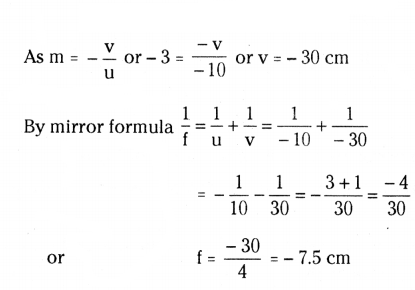
Radius of curvature, R = 2f = 2 × (- 7.5) = - 15 cm.
Question 10.
How far should one hold an object from a concave mirror of focal length 40 cm. So, as to get a virtual image twice the size of the object ?
Answer:
For virtual image, m is + ve
∴ m = - = + 2
or v = - 2u
Also f = - 40 cm
Using mirror formula, 1u+1v=1f ⇒ 1u+1?2u=1?40 ⇒ 12u=1?40
∴ u = -20 cm.
The object should be held at 20 cm from the concave mirror.
Question 11.
An object is kept in front of a concave mirror of focal length 20 cm. The image formed is three times the size of the object. Calculate the two possible distances of the object from the mirror.
Answer:
As the mirror is concave, so f = -20 cm
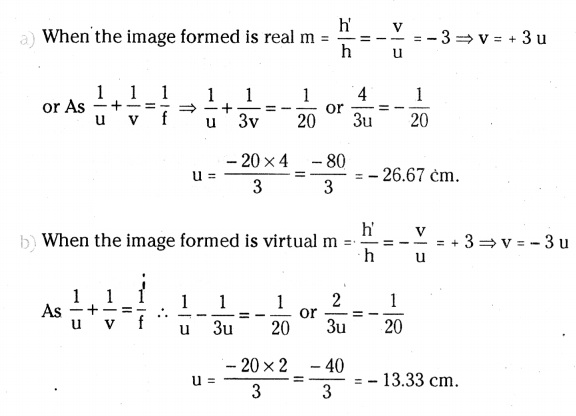
Question 12.
State the laws of refraction of light.
Answer:
Laws of refraction of light : The refraction of light obeys the following two laws.
First law : The incident ray, the refracted ray and normal to the surface of separation at the point of incidence, all lie in the same plane.
Second law : The ratio of the sine of the angle of incidence and the sine of the angle of refraction is constant for a given pair of media.
Mathematically, sinisinr = n21 (a constant)
The constant n21 is called refractive index of the second medium with respect to the first medium. The second law of refraction is also called snell’s law of refraction.
Question 13.
Refractive index of inedia A, B, C and D are
| A |
1.33 |
| B |
1.44 |
| C |
1.52 |
| D |
1.65 |
In which of the four media is the speed of light
i) maximum and (ii) minimum ? Find the refractive index of medium c with respect to medium B.
Answer:
i) Speed of light is maximum in medium A for which n (= 1.33) is minimum,
ii) Speed of light is minimum in medium D for which n (= 1.65) is maximum. Refractive index of medium G with respect to medium B.
nCB = nCnB = 1.521.44 = 1.52
Question 14.
The following table gives the values of refractive indices of a few media.

Use this table to give an example of (i) a medium pair so that light speeds up when it goes from one of these media to another, (ii) a medium pair so that light slows down when it goes from one of these media to another.
Answer:
i) Light speeds up when it goes from a medium of higher refractive index to lower refractive inddx. Say from crown glass to water,
ii) Light slows down when it goes from a medium of lower refractive index to higher refractive index. Say from water to diamond.
Question 15.
Distinguish between a concave and convex lens.
| Convex lens |
Concave lens |
| 1) It is thicker at the centre than at the edges. |
1) It is thinner at the centre than at the edges. |
| 2) It converges a parallel beam of light on refraction through it. |
2) It divergas a parallel beam of light on refraction through it. |
| 3) It has a real focus. |
3) It has a virtual focus. |
Question 16.
State the lens formula, giving the mean ing of the symbols used. Is the some formula applicable to both convex and concave lenses ?
Answer:
Lens formula : The lens formula is mathematical relation between the object distance v, image distance u and focal length ‘f of a spherical lens.
This relation is 1v?1u=1f
In words, we can say that 1 Image distance - 1 Object distance - 1 Focal distance
This formula is applicable to both convex and concave lenses.
Question 17.
If the focal length of this lens is 10 cm and the lens is held at a distance of 5 cm from the palm, use lens formula to find the position and nature of the image.
Answer:
Here u = - 5 cm, f = + 10 cm
Using thin lens formula
1v=1f+1u = 110 + 1?5 = 1-210 = -110
∴ v = -10 cm.
A virtual and erect image is formed at a distance of 10 cm from the lens on the same side as the palm.
Question 18.
You have two lensesi A and B of focal lengths +10 cm and -10 cm respectively. State the nature and power of each lens. Which of the two lenses will form a virtual and magnified image of an object placed 8 cm from the lens ?
Answer:
Here, fA = + 10 cm, fB = - 10 cm
PA = 100+10 + 10D ; PB = 100?10 = -10 D
Lens A is convex and Lens B is concave. Lens A will form a virtual and magnified image when the object is placed at 8 cm from it.
Question 19.
Observe the following figure and answer the questions.
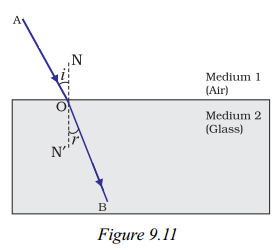
i. What is Figure about ?
Answer:
Figure illustrates the phenomenon of refraction of light through a rectangular glass slab.
ii. What does the figure show ?
Answer:
The figure shows a ray of light obliquely incident on the surface of the glass slab.
It depicts the incident ray, the refracted ray, and the emergent ray.
iii. What observations can be made from the figure ?
Answer:
The emergent ray is parallel to the incident ray, but slightly shifted sideward. The extent of bending of the ray at the opposite parallel faces of the glass slab is equal and opposite, resulting in the parallelism of the emergent ray.
iv. What can be inferred from the figure ?
Answer:
The figure demonstrates that when light passes through the glass slab, it changes direction due to refraction, and the extent of bending at the two surfaces is equal and opposite, resulting in a parallel emergent ray
Question 20.
Observe the following figures and answer the questions.
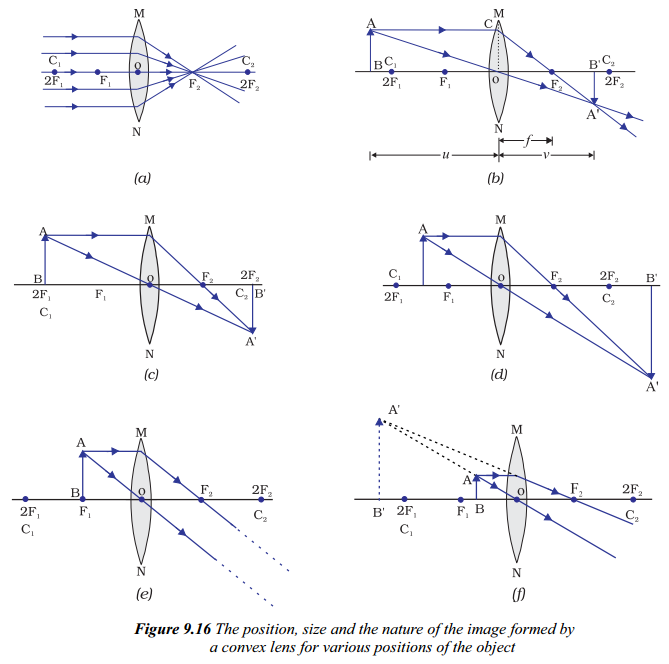
i. What does Figure show ?
Answer:
Figure shows the position, size, and nature of the image formed by a convex lens for various positions of the object.
ii. What does the figure illustrate about the position, size, and nature of the image formed by a convex lens ?
Answer:
The figure illustrates how the position, size, and nature of the image formed by a convex lens change based on the object’s position.
iii. In which positions of the object is the image formed by a convex lens shown in Figure ?
Answer:
The image formation by a convex lens is shown in Figures for different positions of the object, such as at infinity, between infinity and the pole of the lens, and between the focus and the lens.
Question 21.
Observe the following figures and answer the questions.
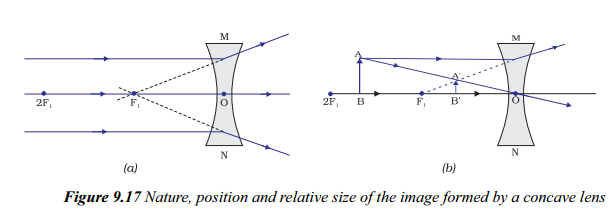
i. What does Figure depict?
Answer:
Figure illustrates the nature, position, and relative size of the image formed by a concave lens.
ii. How does the position of the object affect the image formed by a concave lens?
Answer:
The position of the object in relation to focus F1, focus F2, and the optical centre O determines the nature, position, and relative size of the image formed by a concave lens.
iii. What are the different positions of the object?
Answer:
The positions of the object for studying the image formed by a concave lens include: at infinity, between infinity and the optical centre O of the lens, and between focus F1 and the optical centre O.
Question 22.
Read the paragraph and answer the questions.
Answer:
concave mirror is a spherical mirror that curves inward, like a spoon. When light rays reflect off a concave mirror, they converge at a point called the focus. The distance between the focus and the mirror is called the focal length. The image formed by a concave mirror depends on the position of the object relative to the mirror. When the object is placed beyond the focal point, a real and inverted image is formed, which can be projected onto a screen. When the object is placed between the focal point and the mirror, a virtual and upright image is formed, which cannot be projected onto a screen.
i. What is a concave mirror ? How does it differ from a convex mirror ?
Answer:
A concave mirror is a spherical mirror that curves inward, like a spoon. It differs from a convex mirror, which curves outward.
ii. What is the focal length of a concave mirror? How is it related to the focus ?
Answer:
The focal length of a concave mirror is the distance between the mirror and the focus. The focus is the point where the light rays converge after reflecting off the mirror.
iii. How does the position of the object relative to the concave mirror affect the image formed ?
Answer:
The position of the object relative to the concave mirror affects the image formed. When the object is placed beyond the focal point, a real and inverted image is formed, which can be.projected onto a screen. When the object is placed between the focal point and the mirror, a virtual and upright image is formed, which cannot be projected onto a screen.
iv. What is the difference between a real and an inverted image and a virtual and an upright image ?
Answer:
A real and inverted image is formed when the object is placed beyond the focal point of the mirror and can be projected onto a screen. A virtual and upright image is formed
when the object is placed between the focal point and the mirror and cannot be projected onto a screen.
Question 23.
Case : Noor, a young student, was trying to demonstrate some properties of light in her Science project work. She kept ‘X’ inside the box (as shown in the figure) and with the help of a laser pointer made light rays pass through the holes on one side of the box. She had a small butter-paper screen to see the spots of light being cast as they emerged.
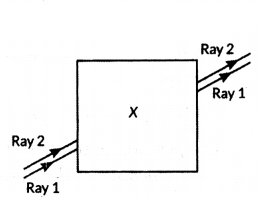
i) What could be the ‘X’ that she placed inside the box to make the rays behave as shown ?
a) A converging lens
b) A parallel-sided glass block
c) A plane mirror
d) A triangular prism
Answer:
b) A parallel-sided glass block
ii) She measured the angles of incidence for both the rays on the left side of the box to be 48.6°. She knew the refractive index of the material ‘X’ inside the box was 1.5. What will be the approximate value of angle of refraction ?
a) 45°
b) 40°
c) 30°
d) 60°
(Use the value: sin 48.6° ? 0.75)
c) 30°
iii) Her friend noted the following observations from this demonstration :
i) Glass is optically rarer than air.
ii) Air and glass allow light to pass through them with the same velocity.
iii) Air is optically rarer than glass.
iv) Speed of light through a denser medium is faster than that of a rarer medium.
v) The ratio: sin of angle of incidence in the first medium to the ratio of sin of angle of refraction in the second medium, gives the refractive index of the second material with respect to the first one.
Which one of the combination of the above statements given below is correct ?
a) (ii), (iv) and (v) are correct
b) (iii) and (iv) are correct
c) (i), (iv) and (v) are correct
d) (iii) and (v) are correct.
Answer:
d) (iii) and (v) are correct.
iv) If the object inside the box was made of a material with a refractive index less than 1.5, then the
a) lateral shift of the rays would have been less.
b) lateral shift of the rays would have been more.
c) lateral shift of the rays would remain the same as before.
d) there is not enough information to comment on any of the above statements.
Answer:
a) lateral shift of the rays would have been less.
Question 24.
AB and CD, two spherical mirrors, from parts of a hollow spherical ball with its centre at O as shown in the diagram. If A, arc AB = 1/2 arc CD, what is the ratio of their focal lengths? State which of the two mirrors will always form virtual image of an object placed in front of it and why ?
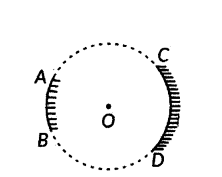
Answer:
- Focal length of a mirror is given by Focal length = Radius of curvature 2
- Since both the mirrors have same radius of curvature, therefore focal lengths of the two mirrors will be same, i.e., f1f2 = 11
- Since virtual image is always formed by convex mirror.
- The mirror AB will always form virtual image.
Question 25.
Define the following terms in the context of a diverging mirror :
i) Principal focus
ii) Focal length
Draw a labelled ray diagram to illustrate your answer.
Answer:
For a diverging mirror :
i) Principal Focus : It is a point where ray parallel to principal axis appears to meet after reflection from the mirror.
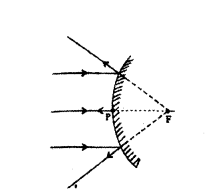
ii) Focal Length : It is distance between pole and principal focus.
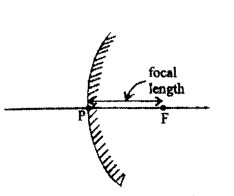
Question 26.
A student holding a mirror in his hand, directed the reflecting surface of the mirror towards the Sun. He then directed the reflected light on to a sheet of paper held close to the mirror.
a) What should he do to burn the paper ?
b) Which type of mirror does he have ?
c) Will he able to determine the approximate value of focal length of this mirror from this activity ?
Give reason and draw ray diagram to justify your answer in this case.
Answer:
a) To burn the paper, student should move (adjust) the mirror in such a way that paper is positioned at the focus of the mirror.
b) He has concave mirror.
c) Yes, approximate value of focal length can be measured from this activity as paper will start burning when it is kept at the focus of the mirror.
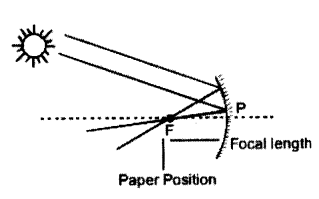
Question 27.
If the image formed by a spherical mirror for all positions of the object placed in front of it is always erect and diminished, what type of mirror is it ? Draw a labelled ray diagram to support your answer.
Answer:
Convex mirror: It forms an image smaller than that of the object.
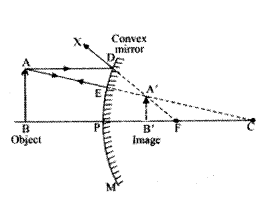
Question 28.
Draw the following diagram, in which a ray of light is incident on a concave/convex mirror, on your answer sheet. Show the path of this ray, after reflection, in each case.

Answer:

Question 29.
If the image formed by a mirror for all positions of the object placed in front of it is always erect and diminished, what type of mirror is it ? Draw a ray diagram to justify your ansWer. Where and why do we generally use this type of mirror ?
Answer:
Convex mirror always forms image erect and diminished, for all positions of the object placed in front of it.
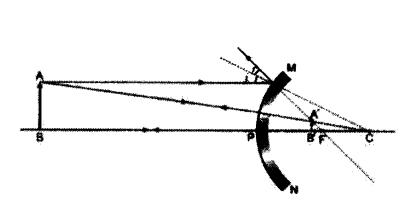
Use : Convex mirror are commonly used as rear-view mirrors in vehicles because they always give an erect image.
Question 30.
A light ray enters from medium A to medium B as shown in the figure.
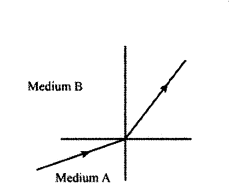
a) Which one of the two media is denser w.r.t. other medium ? Justify your answer.
b) If the speed of light in medium A is v
a and in medium B is v
b what is the refractive index of B with respect to A?
Answer:
a) As light is bending towards normal so ray is moving from rarer medium to denser medium. So medium ‘B’ is denser w.r.t. medium ‘A’.
b) Refractive index of ‘B’ w.r.t. ‘A’ is given as
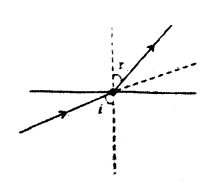

Question 31.
a) A ray of light starting from diamond is incident on the interface separating diamond and water. Draw a labelled ray diagram to show the refraction of light in this case.
b) Absolute refractive indices of diamond and water are 2.42 and 1.33 respectively. Find the value of refractive index of water w.r.t. diamond.
Answer:
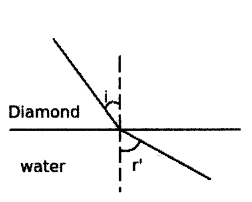
a) As ray is moving from diamond (denser) to water (rarer), so ray will bend away from normal.
b) Refractive index of water W.r.t. diamond is given as μWμD
So, μWμD = 1.332.42 = 133242
Question 32.
The absolute Refractive indices of glass and water are 43 and 32 respectively, If the speed of light in glass is 2 × 108 m/s, calculate the speed of light in (i) vacuum, (ii) water,
Answer:
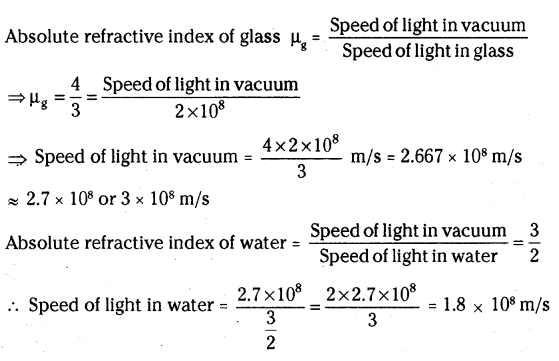
Question 33.
The power of a lens is +4D. Find the focal length of this lens. An object is placed at a distance of 50 cm from the optical centre of this lens. State the nature and magnification of the image formed by the lens and also draw a ray diagram to justify your answer.
Answer:
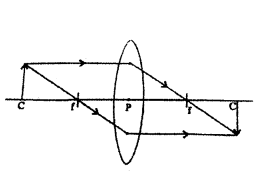
We have f = 1p = 14m = 25 cm and u = -50
By lens formulae 1v?1u=1f ⇒ 1v?1?50=125 ⇒ 1v=125?150 ⇒ 1v=2?150
⇒ 1v = 150 ⇒ v = 50 cm
So, m = vu = 50?50 = -1
So, image will formed on the other side of lens and will be real inverted and same size as object as shown in figure.
Question 34.
A 10 cm tall object is placed perpendicular to the principal axis of a convex lens of focal length 12 cm. The distance of the object from the lens is 18 cm. Find the nature, position and size of the image formed.
Answer:
Given
Distance of object from the lens, u = -18 cm
Focal length of convex lens, f = 12 cm ; Height of the object, ho = 10 cm

Nature of the image : Real and inverted.
Question 35.
The image formed by a spherical mirror is real, inverted and its magnification is - 2. If the image is at a distance of 30 cm from the mirror, where is the object placed? Find the focal length of the mirror. List two characteristics of the image formed if the object is moved 10 cm towards the mirror.
Answer:
Since the image formed is real and inverted, the mirror is concave.
Magnification, m = ?vu ⇒ -2 = ?vu ⇒ v = 2u
Now, if v = - 30 cm, then u = - 15 cm
As focal length of the mirror is
f = vu+v = 15×?30?15?30 = f = 450?45 = -10 cm
If the object is shifted 10 cm towards the mirror, then the object is between principal focus and the optical centre and the image formed will be virtual and erect.
Question 36.
A spherical mirror produces an image of magnification - 1 on a screen placed at a distance of 50 cm from the mirror.
a) Write the type of mirror,
b) Find the distance of the image from the object.
c) What is the focal length of the mirror ?
d) Draw the ray diagram to show the image formation in this case.
Answer:
a) Concave mirror
b) Magnification, m = - v/u or v = u
∴ Distance of the image from the object is, v - u = 0
c) As the image of formed at centre of curvature i.e., v = R.
∴ focal length of the mirror, f = - 50/2 = - 25 cm
d) Object is placed at C.
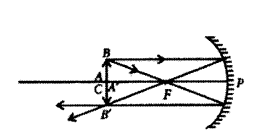
Question 37.
A spherical mirror produces an image of magnification - 1 on a screen placed at a distance of 50 cm from the mirror.
i) Write type of mirror.
ii) What is the nature of the image formed?
iii) How far is the object located from the mirror?
iv) Draw the ray diagram to show the image formation in this case.
Answer:
i) This is a concave mirror.
ii) The image is real and inverted and of same size.
iii) As m = - 1
∴ m = ?vu ⇒ -1 = ?vu ⇒ u = v ⇒ u = -40cm
Hence, object is located at centre of curvature i.e., at distance of 40 cm from the people of the mirror.
∴ focal length f = ?402 = -20 cm
iv) Object is placed at C.
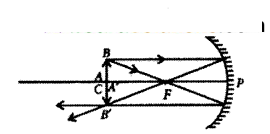
Question 38.
A spherical mirror1 produces an image of magnification -1.0 on a screen placed at a distance of 30 cm from the pole of the mirror.
i) Write the type of mirror in this case.
ii) What is the focal length of the mirror?
iii) What is the nature of the images formed?
iv) Draw the ray diagram to show the image formation in this case.
Answer:
i) This mirror is concave mirror.
ii) Distance the image from the mirror = -30 cm
Magnification, m = ?vu
Here, m = - 1 and v = -30cm ⇒ -1 = -(-30) ∴ u = - 30 cm
As v = u, object is placed at centre of curvature. Therefore, focal length of the mirror, f = ?302 = -15 cm
iii) Image formed is real and inverted and of the same size of the object.
iv) Object is placed at C.
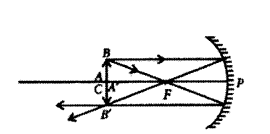
Question 39.
A student wants to obtain an erect image of a candle flame using a concave mirror of focal length 15 cm. What should be the range of distance of the candle flame from the mirror? State the nature and size of the image he is likely to observe. Draw a ray diagram to show the imgge formation in this case.
Answer:
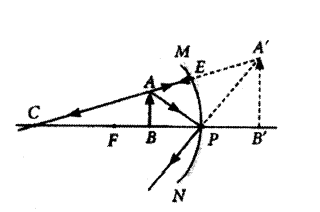
To obtain an erect image of an object, the object should be placed in between pole and focus. Range of distance of the candle flame from the mirror is in between 15 cm.
Nature of the image = Virtual and erect
Size of the image = Enlarged
Question 40.
A real image 2/3rd of the size of an object is formed by a convex lens when the object is at a distance of 12 cm from it. Find the focal length of the lens.
Answer:
Given : h’ = 23 h, u = - 12 cm

Focal length of the convex lens = 4.8 cm
Question 41.
A concave mirror of focal length 10 cm can produce a magnified real as well as virtual image of an object placed in front of it. Draw ray diagrams to justify this statement.
Answer:
A magnified real image is produced in a concave mirror when the object is placed between principal focus and centre of curvature.

A magnified virtual image is produced in a concave mirror when the object is placed between the pole and the principle focus of the mirror.
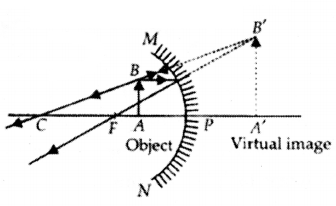
Question 42.
Analyse the following observation table showing variation of image distance (v) with object distance (u) in case of a convex lens and answer the questions that follows, without doing any calculations :
| S.No. |
Object distance (u cm) |
Image distance v (cm) |
| 1. |
-90 |
+18 |
| 2. |
-60 |
+20 |
| 3. |
-30 |
+30 |
| 4. |
-20 |
+60 |
| 5. |
-18 |
+90 |
| 6. |
-10 |
+100 |
a) What is the focal length of the convex lens ? Give reason in support of your answer.
b) Write the serial number of that observation which is not correct. How did you arrive at this conclusion ?
c) Take an appropriate scale to draw ray diagram for the observation at S. No.4. and the approximate value of magnification.
Answer:
a) When an object placed at 2F from a convex lens, then its image is formed on the other side of the lens at the same distance from the lens. Thus from S. No.(3) we can say that.
f = v2 ⇒ f = 302 = +15 cm
Thus, the focal length is +15 cm.
b) In this case S.No. (6) is incorrect as the object distance is between focus and pole, for such case, the image formed is virtual and on the same side as the object, hence image distance is negative.
c) The approximate value of magnification for object distance -20 cm and image distance +60 cm is -3
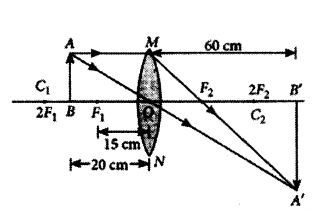
Question 43.
The ability of a medium to refract light is expressed in terms of its optical density. Optical density has a definite connotation. It is not the same as mass density. On comparing two media, the one with the large refractive index is optically denser medium than the other. The other medium with a lower refractive index is optically rarer. Also the speed of light through a given medium is inversely proportional to its optical density.
i) Determine the speed of light in diamond if the refractive index of diamond with respect of vacuum is 2.42. Speed of light in vacuum is 3 × 108m/s.
ii) Refractive indices of glass, water and carbon disulphide are 1.5, 1.33 and 1.62 respectively. If a ray of light is incident in these media at the same angle (say ?), then write the increasing order of the angle of refraction in these media.
iii) The speed of light in glass 2 × 108 m/s and in water is 2.25 × 108 m/s.
a) Which one of the two is optically denser and why ?
b) A ray of light is incident normally at the water - glass interface when it enters a thick glass container filled with water. What will happen to the path of the ray after entering the glass ? Give reason.
Answer:
i) We have v = cμ = =3×1082.42 = 1.24 × 108 m/s
ii) We know that, sinisinr = µ ⇒ sinr = siniμ
So, if µ increases then sin r decreases i.e., r decreases.
Therefore, when µ = 1.62, r is minimum
when µ = 1.33, r is maximum
when µ - 1.5, r is greater than (µ = 1.62)
but less than (µ = 1.33)
iii) a) Glass is optically denser as speed of light in glass is less than that in water.
b) Path of light will remain straight throughout because for normal incidence, i = 0 and therefore r = 0.
Extra Questions on Light Reflection and Refraction Class 10 - 8 Marks
Question 1.
State the rules used for drawing images formed by spherical mirrors.
Answer:
Rules for drawing images formed by spherical mirrors : The position of the image formed by spherical mirrors can be found by considering any two of the following rays of light coming from a point on the object.
i) A ray proceeding parallel to the principal axis will, after reflection, passes through the principal focus in the case of a concave mirrors [Fig.(a)], and appears to come from focus in the case of a convex mirror [Fig.(b)].
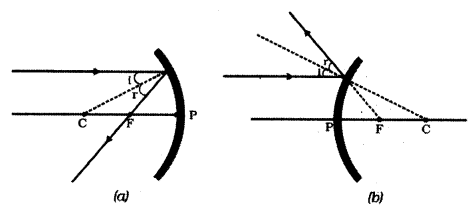
ii) A ray passing through the principal focus in the case of a concave mirror [Fig.(a)], and directed towards the principal focus in the case of a convex mirror [Fig.(b)] Will after reflection, become parallel to the principal axis.
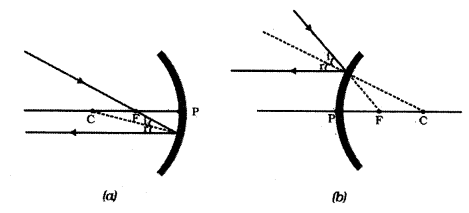
iii) A ray passing through the centre of curvature in the case of a concave mirror (fig. (a)) and directed towards the centre of curvature in the case of a convex mirror (fig. b)) falls normality (∠i = ∠r = 0°) and is reflected back along the same path.
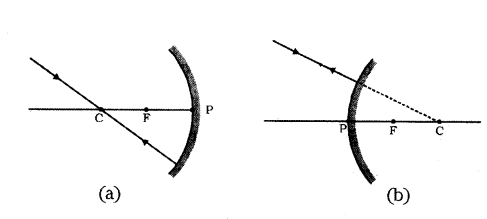
iv) A ray incident obliquely to the principal axis, towards the pole (P), on the concave mirror (fig. (a)) or convex mirror (fig. (b)) is reflected obliquely, following the laws of reflection at the point of incidence, i.e., the incident and reflected rays make equal angles with the principal axis.
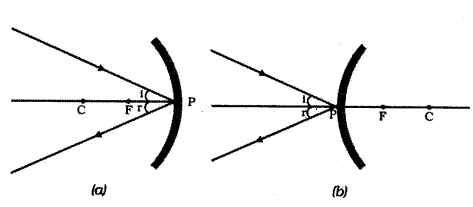
Question 2.
Write the uses of concave and convex mirrors.
Answer:
Uses of concave mirrors:
- Concave mirrors are commonly used in torches, search-lights and vehicles headlights to get powerful parallel beams of light.
- They are often used as shaving mirrors to see a larger image of the face.
- The dentists use concave mirrors to see large images of the teeth of patients.
- Large concave mirrors are used to concentrate sunlight to produce heat in solar furnaces.
Uses of convex mirrors:
- Convex mirrors are commonly used as rear-view (wing) mirrors in vehicles.
- These mirrors are fitted on the sides of the vehicle, enabling the driver to see traffic behind him/her to facilitate safe driving.
Question 3.
State the new cartesian sign convention followed for reflection of light by spherical mirrors.
Answer:
New cartesian sign convention for reflection by spherical mirrors : According to this convention :
- The object is on the left of the mirror. So all the ray diagrams are drawn with the incident light travelling from left to right.
- All the distances parallel to the principal axis are measured from the pole of the mirror.
- All distances measured in the direction of incident light are taken as positive.
- All distances measured in the oppsoite direction of incident light are taken as negative.
- Heights measured upwards and perpendicular to the principal axis are taken positive.
- Heights measured downwards and perpendicular to the principal axis are taken negative.

Question 4.
a) Two lenses have power of (i) + 2D (ii) - 4D. What is the nature and focal length of each lens ?
b) An object is kept at a distance of 100 cm from each of above lenses. Calculate the (i) image distance, (ii) magnification in each of the two cases.
Answer:
a) i) Here P = + 2D
∴ f = 1p = 1+2m = + 50 cm
The positive sign shows that the lens is convex,
ii) Here P = -4D
f = 1p = 1?4m = -25 cm
The negative sign shows that the lens is concave.
b) i) Here, f = + 50 cm, u = -100 cm
By lens formula 1v?1u=1f
∴ 1v?1f=1u = 150 + 1?100 = 2-1100 = 1100
⇒ Image distance v = 100 cm
Magnification, m = vu = 100?100 = -1.
ii) Here, f = -25 cm, u = -100 cm
∴ 1v?1f=1u = 1?25 + 1?100 = ?4-1100 = -120
(or) image distance v = -20 cm
Magnification, m = vu = ?20?100 = vu = 15 = 0.2.
Question 5.
The path of a fight ray from all to three different media A, B and C for a given angle of incidence is shown below. Study the diagrams and answer the following questions.

i) Which of the three media A, B and C has maximum optical density ?
ii) Through which of the three media, will the speed of light be maximum ?
iii) Will the light travelling from A to B bend towards or away from the normal ?
iv) Will the refractive Index of B relative to C be more than unity or less than unity?
Answer:
n = sinisinr = cv
i) sin 30° < sin 40° < sin 45° ⇒ nA > nC > nB
∴ Medium A has maximum optical density.
ii) Speed of light will be maximum in the medium B of lowest refractive index nB.
iii) As nA > nB, light travelling from A to B will bend away from the normal.
iv) Refractive index of B relative to C is
nBC = nBnC < 1 (? nB < nC)
Question 6.
a) Define the following terms in the context of spherical mirrors :
i) Pole
ii) Centre of curvature
iii) Principal axis
iv) Principal focus
b) Draw ray diagrams to shoy the principal focus of a (i) concave mirror (If) convex mirror.
Answer:
a) i) Pole : The central point of the reflecting spherical surface is called the pole (P). It lies on the surface of the mirror.
ii) Centre of Curvature : The centre of the hallow sphere of which the spherical mirror is a part, is called the centre of curvature (C).
iii) Principal Axis: The straight line joining the pole and the centre of curvature is called the principal axis.
iv) Principal Focus: The point ‘F on the principal axis, where the incident light rays parallel to the principal axis actually meet (converge) (in case of concave mirror) or appear to diverge or come from (in case of convex mirror) after reflection is called its principal focus (F).
b) 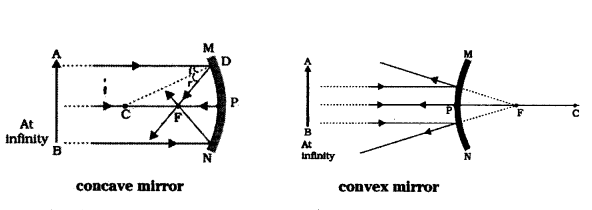
Question 7.
a) Find the absolute refractive index of a medium in which light travels with a speed of 1.4 × 108 m/s.
b) How do we distinguish a medium to be rarer or denser ? Give two reasons.
Answer:
a) Absolute refractive index of the medium is given by
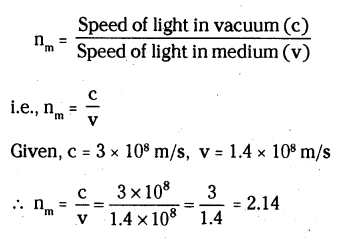
b) i) Based on the bending of light.
ii) Based on the velocity of light in the medium or by knowing its refractive index.
Question 8.
a) The refractive index of a medium ‘X’ with respect to ‘Y’ is 23 and the refractive
index of medium ‘Y’ with respect to ‘Z’ is 43 . Calculate the refractive index of medium ‘Z’ with respect of ‘X’.
b) The paper will burn, because the heat energy of the sun is also concentrated on a small part of paper, i.e., at the principal focus, where the convex lens forms a sharp image of the sun.
Answer:
a) Given, nXY = 23, nYZ = 43, nZX =?
We know that nXY × nYZ × nZX = 1
⇒ 23 × 43 × nZX = 1 ⇒ nZX = 98
b) The paper will burn, because the heat energy of the sun is also concentrated on a small part of paper, i.e., at the principal focus, where the convex lens forms a sharp image of the sun.
Question 9.
How can you obtain a sharp bright image of a burning candle using a concave mirror ?
Answer:
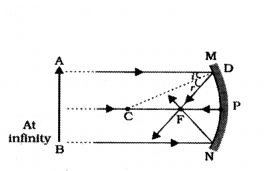
To obtain a sharp bright image of a burning candle using a concave mirror, you can follow these steps :
- Take a concave mirror and place it on a stand, ensuring that the pole of the mirror lies over a marked line on a table.
- Draw two parallel lines on the table, with the distance between them equal to the focal length of the mirror. These lines represent the positions of the points P (pole), F (focus), and C (center of curvature).
- Position a burning candle far beyond point C and place a paper screen in front of the mirror. Move the screen back and forth until a sharp, bright image of the candle flame is formed on it.
- Hold the mirror and the paper in the same position for a few minutes and observe the image.
Question 10.
What does Figure illustrate about spherical mirrors ?
Answer:
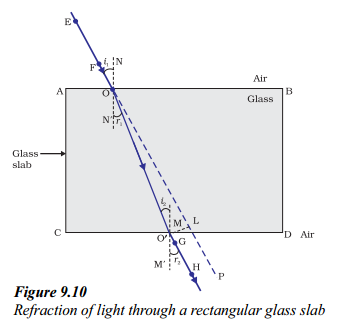
- Figure shows the formation of an image by a concave mirror with a beam of parallel rays of light.
- It demonstrates that the rays of light parallel to the principal axis converge.at a point known as the principal focus of the mirror.
- This shows how a concave mirror can form a real, inverted, and diminished image when the object is beyond the center of curvature.
- The image size and position depend on the position of the object relative to the mirror.
- The figure highlights the importance of the principal focus and center of curvature in determining the characteristics of the image formed by a concave mirror.
Question 11.
How do convex and concave lenses differ in terms of their action on light rays ?
Answer:
- Convex lenses, as shown in Figure (a) have a converging action on light rays.
- When parallel rays of light pass through a convex lens, they converge to a point on the principal axis called the principal focus.
- On the other hand, concave lenses, as shown in Figure (b) have a diverging action on light rays.
- When parallel rays of light pass through a concave lens, they appear to diverge from a point on the principal axis called the principal focus.
Question 12.
A spherical mirror produces an image of magnification - 1 on a screen placed at a distance of 50 cm from the mirror.
a) Write the type of mirror.
b) Find the distance of the image from the object.
c) What is the focal length of the mirror ?
d) Draw a ray diagram to show the image formation in this case.
Answer:
a) As magnification is negative, the image of formed by mirror is real. Hence, it is a concave mirror.
b) Magnification m = ?vu = -1 ∴ u = v = -50 cm
Distance of the image from the object v - u = - 50 - (- 50) = 0 cm.
c) By using mirror formula : 1f=1v+1u = 1(?50) + 1(?50) = ?125 = -25cm
d) 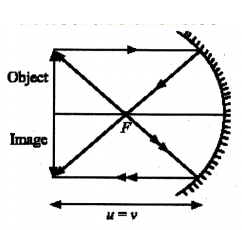
Question 13.
What is the phenomenon of dispersion observed in a glass prism ?
Answer:
The phenomenon of dispersion is observed in a glass prism :
- Dispersion refers to the splitting of white light into its constituent colours when it passes through a prism.
- This occurs because different colours of light have different wavelengths and therefore undergo different amounts of refraction when entering and exiting the prism.
- The red light bends the least, while violet light bends the most.
- As a result, when white light passes through a prism, it spreads out into a spectrum of colours, with red on one end and violet on the other.
- This phenomenon is responsible for the rainbow of colours seen when sunlight is refracted by raindrops in the atmosphere.
- The dispersion of light in a prism is also the basis for the creation of spectrums and the study of spectroscopy.
Question 14.
What are the differences between concave mirror and convex mirror ?
|
Concave Mirror |
Convex Mirror |
| Reflecting Surface |
Curved inwards, facing towards the center of the sphere |
Curved outwards |
| ImageFormation |
Real and inverted images based on the object’s position |
Virtual and erect images |
| Image Size |
Can produce magnified, reduced, or same-sized images |
Always produces reduced images |
| Common Uses |
Torches, search-lights, vehicle headlights, shaving mirrors, solar furnaces |
Rear-view mirrors for vehicles. |
Question 15.
A concave mirror has a focal length of 20 cm. At what distance from the mirror should a 4 cm tall object be placed so that it forms an image at a distance of 30 cm from the mirror ? Also calculate the size of the image formed.
Answer:
Concave mirror: f = -20 cm, h = +4 cm, v = -30 cm, u = ?, h = ?
According to mirror formula.
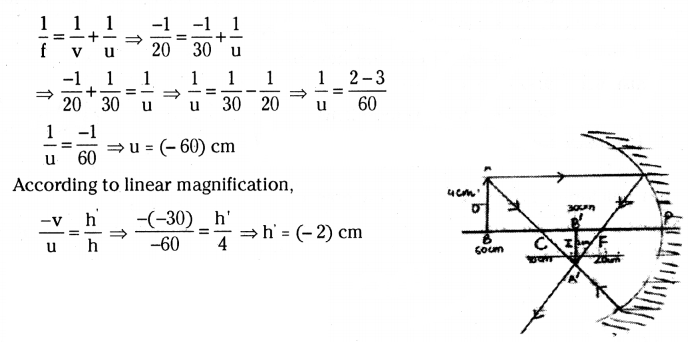
Image
Nature : Real and inverted
Position; Between C & F at 30 cm
Size : Smaller than object (Diminished)
Question 16.
If the image formed by a lens for all position of an object placed in front of it is always erect and diminished, what is the nature of this lens ? Draw a ray diagram to justify your answer. If the numerical value of the power of this lens of 10 D, what is its focal length in the Cartesian system ?
Answer:
If the image formed by a lens for all positions of the object in front of it is always virtual, erect and diminished, the lens is concave,
i) When object is at infinity object is formed at focus F1.
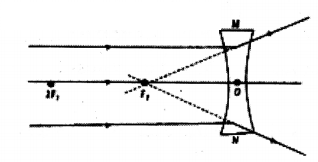
ii) When object is between infinity and optical centre (O) of lens - image is formed between focus and optical centre of lens.
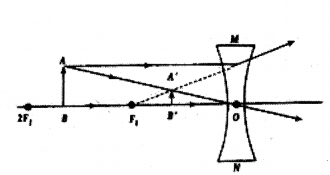
Power of the lens. p = 1f(inm)
⇒ 10 = ?1f ⇒ f = ?110
∴ Focal length, f = -0.1 m
Question 17.
The image of an object formed by a lens is of magnification - 1. If the distance between the object and its image is 60 cm, what is the focal length of the lens ? If the object is moved 20 cm towards the lens, where would the image be formed ? State reason and also draw a ray diagram in support of your answer.
Answer:
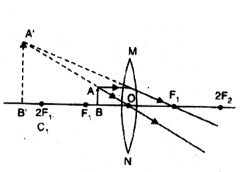
- Image with magnification -1 means image is inverted and of the same size.
- Therefore, object is at 2F and the image is also at 2F on the other side of the lens.
- Therefore, distance between the object and its image is 4f = 60 cm ⇒ f = 15 cm
- Object distance 2f = 30 cm, if the object is shifted towards the lens by 20 cm, the new object distance = 30 cm -20 cm = 10 cm.
- This distance is less than the focal length.
- The image formed in this case would be virtual, erect.
- It will form on the same side as the object.
Question 18.
An object 4.0 cm in size, is placed 25.0 cm in front of a concave mirror of focal length 15.0 cm.
i) At what distance from the mirror should a screen be placed in order to obtain a sharp image ?
ii) Find the size of the image.
iii) Draw a ray diagram to show the formation of image in this case.
Answer:
Given, Size of the object, ho = 4 cm
Distance of the object, u = -25 cm ; Focal length of concave mirror, f = -15 cm
Using mirror formula, 1v=1u+1f
⇒ 1v - 125 = 1?15 ⇒ 1v = ?115 + 125 = ?5+375
⇒ v = ?752 = -37.5 cm
i) As the sign of v is negative, so the image should be in front of the mirror. The screen should be placed in front of the mirror at a distance of 37.5 cm.
ii) Magnification, m = vu = h1 ho ⇒ (37.5)25 = hi4 ⇒ hi = 37.5×425
∴ Size of the image, hi = 6 cm
iii) Ray diagram to show the formation of image.
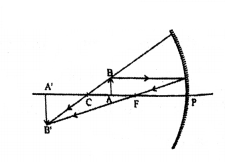
Question 19.
Draw a ray diagram in each of the following cases to show the formation of image, when the object is placed.
i) between optical centre and principal focus of a convex lens.
ii) anywhere in front of a concave lens.
iii) at 2F of a convex lens.
Answer:
i) Ray diagram when the object is placed between optical centre and principal focus of a convex lens.
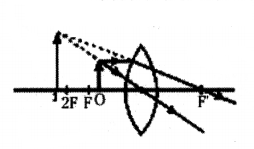
Magnification m = height of image height of object (m < 1)
ii) Ray diagram when the object is placed anywhere in front of a concave lens.
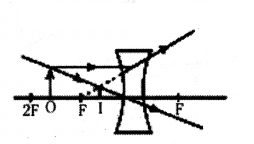
Magnification m = height of image height of object (m < 1)
iii) Ray diagram when object is placed at 2F of a convex lens.
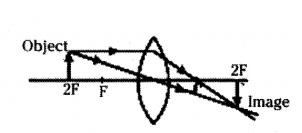
Question 20.
An object is placed at a distance of 60 cm from a concave lens of focal length 30 cm.
i) Use lens formula to find the distance of the image from the lens.
ii) List four characteristics of the image (nature, position, size, erect/inverted) formed by the lens in this case.
iii) Draw ray diagram to justify your answer of part (ii)
Answer:
i) Given, Object distance, u = -60 cm
Focal length of the concave lens, f = -30 cm
Using of the formula, 1v?1u=1f
⇒ 1v - 1(?60) = 1(?30) ⇒ 1v = ?130 - 160 = ?360 ⇒ v = -20 cm
Thus, the image will be formed at a distance of 20 cm infront of the lens.
ii) The characteristics of the images are
a) Nature of the image is virtual.
b) Image is erect
c) Size of the image is diminished
d) The image is formed at distance of 20 cm from the optical center of the contave lens on the same side of the object.
iii) 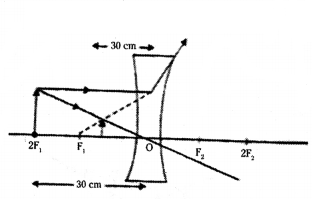
Question 21.
Analyse the following observation table showing variation of image - distance (v) with object - distance (u) in case of a convex lens and answer the question that follow without doing any calculation :
| S.No. |
Object distance u (cm) |
Image distance v (cm) |
| 1 |
-100 |
+25 |
| 2 |
-60 |
+30 |
| 3 |
-40 |
+40 |
| 4 |
-30 |
+60 |
| 5 |
-25 |
+100 |
| 6 |
-15 |
+120 |
i) What is the focal length of the convex lens ? Give reason to justify your answer.
ii) Write the serial number of the observation which is not correct. On what basis have you arrived at this conclusion ?
iii) Select an appropriate scale and draw a ray diagram for the observation at S.No. 2. Also find the approximate value of magnification.
Answer:
i) The focal length of the convex lens can be calculated from S.No. 3 as when an object is placed at a distance from the convex lens its image is formed on the other side of the lens at the same distance from the lens. So, the radius of curvature is 40 cm.
Thus, focal length is half the radius of curvature (f = R2) i.e.,
f = R2 = +20 cm.
ii) S.No. 6 is incorrect as the objects distance is between focus and pole and this always forms virtual and erect image of object so image distance is negative but the image distance given is positive (+120 cm).
iii) 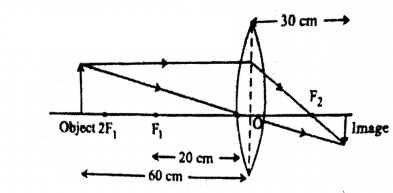
Approximate value of magnification for object distance u = -60 cm and image distance v = +30 cm is i.e., m = vu = 3060 = 0.5.
Question 22.
What is meant by power of a lens ? Define its S.I. unit. You have two lenses A and B of focal lengths +10 cm and -10 cm respectively. State the nature and power of each lens. Which of the two lenses will form a virtual and magnified image of an object placed 8 cm from the lens ? Draw a ray diagram to justify your answer.
Answer:
The power of a lens is defined as the reciprocal of its focal length. It is represeted by the letter ‘P’ The power ‘P’ of a lens of a focal length ‘f’ is given by
P = 1f (where f is in meter)
The S.I. unit of power of a lens is ‘Diopter’. It is denoted by the letter ‘D’.
Lens A of focal length +10 cm is a convex lens.
f = +10 cm or f = +10100m
Now, p = 1f = 110100 = +10010 = +10D
Lens B of focal length - 10cm is a convex lens.
Lens A, convex lens, will form virtual and magnified image of an object placed 8 cm from the lens.
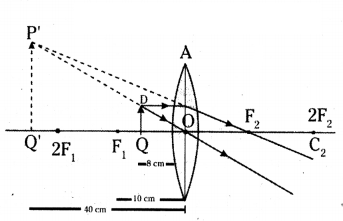
Lens B of focal length - 10cm is a convex lens.
f = -10 cm or f = ?10100m
Now, p = 1f = 1?10100 = -10010 = -10D
Lens A, convex lens, will form virtual and magnified image of an object placed 8 cm from the lens.
Question 23.
It is desired to obtain an erect image of an object, using concave mirror of focal length of 12 cm.
i) What should be the range of distance of a object placed in front of the mirror?
ii) Will the image be smaller or larger than the object ? Draw ray diagram to show the formation of image in this case.
iii) Where will the image of this object be, if it is placed 24 cm in front of the mirror? Draw ray diagram for this situation also to justify your answer.
Show the positions of pole, principal focus and the centre of curvature in the above ray diagrams.
Answer:
Given : focal length of the concave mirror f = 12 cm
i) If the object is placed between the pole and focus of the concave mirror, then the image formed is virtual and erect. Therefore, the range of distance of the object should be 0 < u < 12 cm.
ii) The image formed will be enlarged as shown below.
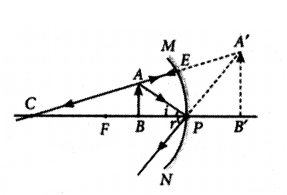
iii) If the object is placed 24 cm in front of the mirror i.e., at the centre of the curvature then the image will also be formed at the centre of the curvature.
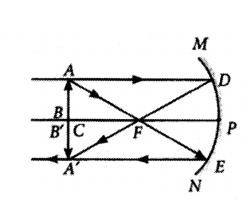
Question 24.
A student has focused the image of a candle flame on white screen using a concave mirror. The situation a given below :
Length of the flame = 1.5 cm ; Focal length of the mirror = 12 cm
Distance of flame from the mirror = 18 cm
If the flame is perpendicular to the principal axis of the mirror, then calculate the following :
a) Distance of the image from the mirror
b) Length of the image
If the distance between the mirror and the flame is reduced to 10 cm, then what would be observed on the screen ? Draw ray diagram to justify your answer on this situation.
Answer:
Given : focal length of the concave mirror, f = -12 cm
Length of the flame, h = 1.5 cm
Distance of flame from the mirror, u = -18 cm
a) As, 1f=1u+1v
or 1v=1f?1u = 1?12 - 1?18 = ?3+236 = ?136
or v = - 36 cm
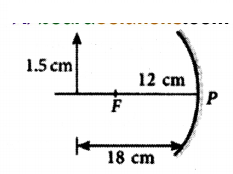
b) Let h’ be the length of the image.
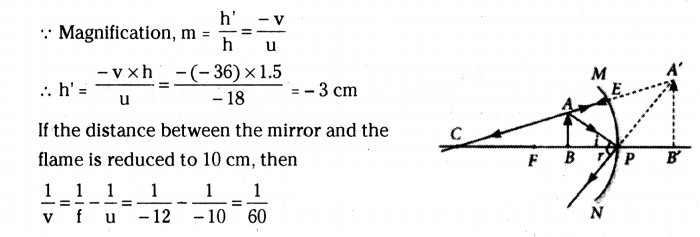
∴ v = 60 cn
Hence, image is formed behind the mirror.
Question 25.
Read the case given below carefully.
A student took three concave mirros of differet focal lengths and performed the experiment to see the image formation by placing an object at different distances with these mirrors as shown in the following table.
| Case No. |
Object-distance |
Focal length |
| I |
45 cm |
20 cm |
| II |
30 cm |
15 cm |
| III |
20 cm |
30 cm |
Now answer the following questions :
a) List two properties of the image formed in Case I.
b) In which one of the cases given in the table, the mirror will form real image of same size and why ?
c) Name the type of mirror used by dentists. Give reason why do they use type of mirrors.
d) Look at the table and identify the situation (object distance and focal length) which resembles the situation in which concave mirrors are used as shaving mirrors ? Draw a ray diagram to show the image of formation in this case.
Answer:
a) Here, | u | = 45 cm and | f | = 20 cm as | u | > | 2f |. So image formed will be (i) real and inverted.
ii) between f and 2f.
iii) smaller than size of object.
b) In case II, image will be formed at centre of curvature and will be real and size same as that of object.
c) Dentist use poncave mirror because when teeth is in between focus (F) and pole (P) of concave hiirror, we get enlarged and erect image behind the mirror.
d) Case III is used as shaving mirror, because when face is between focus (F) and pole (P) of concave mirror, we get enlarged and erect image behind the mirror as shown figure.
